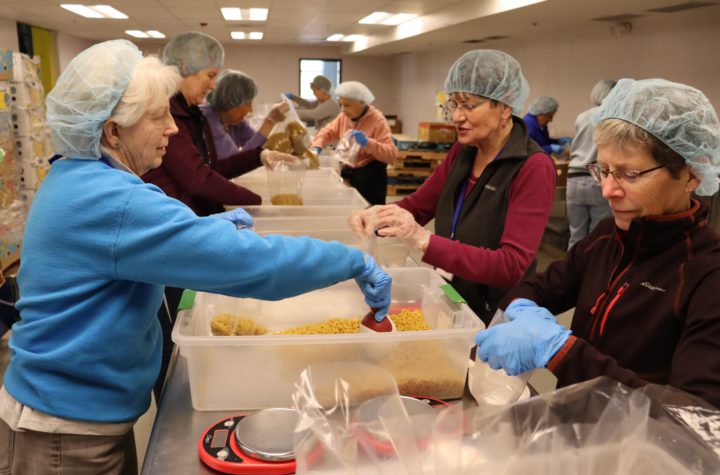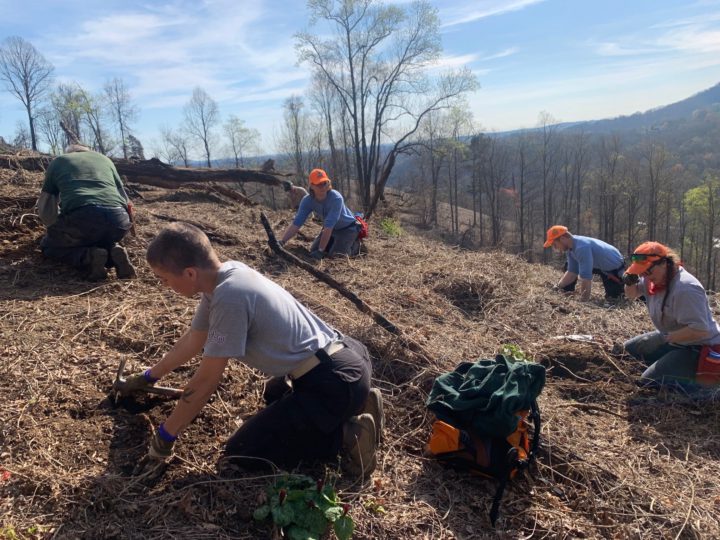After volunteers nearly disappeared from local nonprofits during the COVID-19 pandemic, agency leaders are noting a new normal: Fewer volunteers are working a lot more hours, enabling organizations to meet their growing needs.
Xpress surveyed several local nonprofits from a variety of sectors to find out how they’re meeting increased community needs with fewer resources.
Housing shift
Volunteer numbers took a major hit during COVID at Asheville Area Habitat for Humanity, which builds and repairs houses and works to address the affordable housing crisis. In 2019, 2,311 volunteers served Asheville Habitat, while in 2020 that number was just 592 — a 74% reduction. Similarly, the number of hours volunteered dropped 60% from just over 70,000 to under 27,000 during the same period.
“The pandemic reinforced just how critical volunteers are to Habitat’s work,” says Maddy Alewine, communications specialist. “We served about 25% to 30% fewer families in 2020 and 2021, and ReStore sales in 2020 were about a third their typical performance.”

The ReStores, whose sales help fund the organization, were forced to close for part of 2020. The stores in Asheville and Weaverville are now open five days a week instead of six before COVID, says Carrie Burgin, ReStore volunteer manager.
While Habitat’s volunteer numbers have rebounded since the 2020 drop, the total number of volunteers — 1,618 — is still down 30% compared to the 2019 numbers, and hours are down 24%. Still, Alewine notes that both ReStores brought in a record number of sales during the 2023 fiscal year, grossing more than $4.3 million in sales. “The success of both ReStores speaks to this community’s drive to reduce, reuse and recycle gently used items and to help fund Habitat’s building and repair programs,” said Alewine.
It’s continued to recruit volunteers through “traditional models” including VolunteerMatch, United Way, tabling events and outreach with local schools. Burgin says word of mouth has been their most effective recruiting tool. She believes volunteers feel a sense of commitment and purpose around the mission of building homes, communities and hope.
Health care support
Four Seasons, which provides hospice and palliative care and runs several resale stores, also saw a reduction in numbers during the pandemic. Between 2019 and 2020, the number of volunteers fell 16% and hours dropped 29%.
Sue Ann Hamby, Four Seasons chief quality officer, says, “Once the COVID mandate was lifted and the pandemic was officially over, our volunteers were overwhelmingly ready to come back to the great work of helping meet the needs of patients and their loved ones, being active members of various teams within Four Seasons and serving in person once again.”

Its numbers did rebound, but as of Oct. 26, the year-to-date numbers were still falling short of 2019 levels. While the number of volunteers is down 20%, total hours volunteered were down 12% with two months remaining to lessen the gap.
Leisl Vale, Four Seasons marketing specialist, believes fewer volunteers working more hours could be due to people wanting to “give back as much as they possibly can” after a period of isolation. “I also think a lot of people saw the pressures health care workers are under as the pandemic unfolded,” says Vale. “Many of our volunteers who work directly with our clinical staff express that it’s important to them to take some of the burden off of those employees in any way they can, and I believe they stepped up to support our clinical staff significantly.”
Some volunteers had friends or family served by Four Seasons and felt called to give back, while others learned of the organization through social media, radio and print marketing, and area health and volunteer fairs, says Sheri Merrill, Four Seasons employee and volunteer solutions manager. The nonprofit uses a variety of incentives to keep people committed, including an annual appreciation event in April, an awards night in the fall and group activities such as movie nights. Merrill says they also maintain “a high standard of communication,” regularly reaching out via phone, email and newsletters, and by hosting regional volunteer support meetings.
Food driven
Like Four Seasons, MANNA FoodBank also saw a reduction in the number of volunteers, but a relatively stable number of hours served. Its number of volunteers went down 32% from 4,379 in 2019 to 2,961 in 2022, but the total number of hours hardly changed — from 57,667 in 2019 to 55,032 in 2022 — a decrease of less than 5%.
Volunteer Manager Nicholas Ames believes the organization is seeing more consistent volunteers and a lot fewer “one-off” folks who came individually or with a group once a year. He adds that everyone in the community “is feeling some sort of pinch” from rising costs and may not have the extra time to volunteer because they’re trying to make ends meet themselves.

According to Ames, volunteers have remained critical to MANNA operations at a time when the nonprofit is feeding over 167,000 people per month — the highest numbers in its 40-year history. Without volunteers, whose hours add up to 28 full-time staff members, Ames says, “I don’t know if we would even be able to feed Asheville, let alone the other 16 counties that we are currently covering.”
For its part, Ames says MANNA does very little direct outreach and instead relies on name recognition — MANNA is a well-known organization in the area — to bring in volunteers. He explains that food insecurity and poverty in the area have become much more visible in recent years, and that drives many people to volunteer.
Once on board, MANNA staff make sure volunteers feel appreciated and understand the impact of their work so they’ll keep coming back. That involves “getting to know people on a personal level, really developing relationships with our volunteers, and making sure that the warehouse environment is as fun as possible,” says Ames.
Many of MANNA’s volunteers spend their hours sorting food in a large warehouse. Ames says they play music; have an area where people can go to relax and socialize; and they recently installed a TV with a slideshow of images and quotes from partner agencies to help bring the direct impact of their work to those working behind the scenes. The atmosphere is one that emphasizes community, both for those working together in the room and for the larger community that they serve.
Outside support
While for several nonprofits, the reduced number of volunteers stepped up to fill in the gaps, one group that Xpress spoke to saw a significant reduction in both volunteers and hours served. Conserving Carolina has 60% fewer volunteers with just 155 serving as of Nov. 3 compared to 389 in 2019. The number of hours volunteered has seen an even more dramatic decrease — down to 1,540 from 7,108 — a 78% drop.
The group works to conserve and protect local trails, parks and greenways, and offers educational programs to the public. Pam Torlina, community engagement director, says that despite the numbers, she hasn’t seen a negative impact on the organization. “Our capacity to still do really great work means that those who are really interested and passionate about what we do and volunteering with us have continued and stayed with us for a long time,” says Torlina.

One such longtime volunteer, Carole Bartol, has been with Conserving Carolina since it was established in 2017, serving on the board of directors and the development committee. She says she’s stayed with the nonprofit because she believes its mission is critical and has seen firsthand how its programs impact the local community.
Bartol recalls observing a young boy at an educational event paying rapt attention and reaching out to touch a preserved bird. “You know I’ve always thought about that child after that. That could have been a turning point in his life to get him interested in nature,” says Bartol.
Like MANNA, Conserving Carolina believes part of why its numbers are down is because people who participated only once or twice a year have stopped volunteering. Additionally, prior to the pandemic, university students from across the East Coast would choose to spend their spring break volunteering instead of going to the usual party destinations. COVID restrictions hampered the program and it has yet to rebound, according to Torlina.
Vegetable brigade
Setting itself apart from the other nonprofits Xpress surveyed, Bounty & Soul saw a substantial increase in the number of volunteers in 2020, and the number of hours logged has grown by about 36% since 2019.
From 2019 to 2020, Bounty & Soul’s volunteer numbers jumped from 442 to 629 — a 42% increase. The nonprofit runs several area markets where they distribute fresh produce and offer educational programming, all at no cost to patrons. Like MANNA, it’s seen community need rise exponentially. Karla Gardner, director of community engagement, says market attendance has more than doubled since the start of the pandemic; currently it’s serving about 1,000 households every week.
Gardner believes many people got involved with Bounty & Soul in 2020 because of the increased need and awareness of food scarcity and because many were out of work and looking for opportunities to give back to the community.
While the total number of volunteers dropped after the 2020 surge, numbers are still 20% higher than they were in 2019, while hours have increased 36%. Like Four Seasons and MANNA, fewer people are volunteering more often. Though Bounty & Soul has attracted volunteers through outlets like United Way and VolunteerMatch, it also depends on word of mouth. Gardner says volunteers will have a positive experience at the market and invite friends and neighbors to join. And sometimes market participants, those who benefit from the free produce and programming, volunteer themselves.
Additionally, it’s attracted a diverse group by offering opportunities “for all ages and abilities,” family-friendly shifts, and hosting a Latino market where staff is bilingual and programming is offered in Spanish. During the pandemic, it started a handwritten Love Notes program, designed to “spark joy and spread the love” while giving people the opportunity to contribute remotely.
Like other nonprofits, community building among volunteer staff is essential for Bounty & Soul. “People are hungry for all sorts of different things,” says Gardner. “Somebody might just be craving community connection, and that’s what fills their cup. And being there in that market environment is its own form of nourishment.”
Editor’s note: This article was updated Nov. 20. Carole Bartol’s name was previously misspelled.






Before you comment
The comments section is here to provide a platform for civil dialogue on the issues we face together as a local community. Xpress is committed to offering this platform for all voices, but when the tone of the discussion gets nasty or strays off topic, we believe many people choose not to participate. Xpress editors are determined to moderate comments to ensure a constructive interchange is maintained. All comments judged not to be in keeping with the spirit of civil discourse will be removed and repeat violators will be banned. See here for our terms of service. Thank you for being part of this effort to promote respectful discussion.